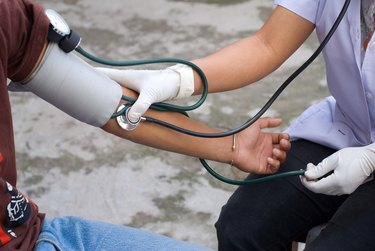
Blood pressure readings don't necessarily have to be done using an arm cuff. It's possible to get a blood pressure reading using your leg instead. In fact, it's possible to get an accurate blood pressure reading at any point where an artery runs near the surface of the skin.
Read more: What Is Blood Pressure, Exactly?
Video of the Day
Video of the Day
Routine Blood Pressure Readings
Getting a blood pressure reading has become a routine fixture of the American health care landscape. For most people, it's a goes-without-saying part of any yearly or biannual visit to your primary caregiver. For others, an occasional free screening at the local pharmacy does the trick.
For people at higher risk — meaning those with a history of high blood pressure — blood pressure readings are even more commonplace because many have followed an American Heart Association recommendation that encourages such people to do frequent home monitoring to ensure that ongoing blood pressure treatments are working.
The practice is both easy and cheap, with experts at Harvard Health Publishing pegging blood pressure home equipment at between $50 and $100. Some insurance plans even cover the cost.
This means that most Americans are all too familiar with the classic sight of an arm-wrapped neoprene cuff slowly pumping up and down. But here's a fact that may be a surprise: Blood pressure readings are not actually limited to the arm.
Why Leg Blood Pressure Readings?
Adding a leg blood pressure reading into the mix can offer you a much broader handle on the true health of your arteries.
"Blood pressure can be measured in the arm, leg or even the foot," says Michael J. Blaha, MD, MPH, director of clinical research at the Johns Hopkins Ciccarone Center for the Prevention of Heart Disease, in Baltimore. "This can be accomplished with a routine automated blood pressure cuff, and a comparison of the blood pressure in the leg or foot to the blood pressure in the arm can uncover circulation problems in the peripheral circulation."
According to experts at the Mayo Clinic, such circulation problems may be of particular concern to people who experience leg pain while walking. That could be a sign of peripheral arterial disease (PAD).
According to experts at the National Heart, Lung, and Blood Institute, PAD can develop when artery-clogging plaque builds up in the legs. Just like clogged heart arteries, PAD significantly raises the risk for a heart attack or stroke. The Mayo Clinic warns that about 10 percent of people older than 55 have it. When symptoms arise, getting an accurate PAD diagnosis sooner rather than later can be critical.
That's where a quick, noninvasive and painless leg-based blood pressure reading can come in handy. Your doctor would first take an ankle-based blood pressure reading and then compare it with a standard arm blood pressure reading. The result is the so-called "ankle-brachial pressure index."
The Ankle-Brachial Pressure Index
"Leg blood pressure is typically 10 to 20 percent higher than arm blood pressure," says Willie E. Lawrence, Jr., MD, chief of cardiology at Midwest Heart & Vascular Specialists in Kansas City, Missouri.
"It is measured in a very similar method as arm blood pressure. You can compare systolic ankle (leg) pressure to systolic brachial (arm) blood pressure, and this is termed the ankle-brachial pressure index (ABPI)," says Dr. Lawrence A low index number, warns the Mayo Clinic, likely indicates arterial narrowing or blockage in the legs.
Beyond the ankle, another alternative is a calf-based blood pressure reading. As noted in a study published in the January-February 2012 issue of the Indian Journal of Anaesthesia, a calf reading could prove useful in situations where people simply don't have a free arm, such as during certain types of surgeries.
That study team cited mastectomy patients, burn victims, trauma patients and amputees as examples of other individuals for whom a calf reading might be the preferred way to go.
- Michael J. Blaha, MD, MPH, director of clinical research, Johns Hopkins Ciccarone Center for the Prevention of Heart Disease, Baltimore
- American Heart Association: "Monitoring Your Blood Pressure at Home"
- Harvard Health Publishing: "How to Monitor - and Lower - Your Blood Pressure at Home"
- National, Heart, Lung, and Blood Institute: "Facts About Peripheral Arterial Disease (P.A.D.)"
- Willie E. Lawrence, Jr., MD, FAHA, FACC., chief of cardiology, Research Medical Center, Midwest Heart & Vascular Specialists, Kansas City, Missouri
- Mayo Clinic: "Ankle-Brachial Index"
- Indian Journal of Anaesthesia: "Comparison of Arm and Calf Blood Pressure"
Is this an emergency? If you are experiencing serious medical symptoms, please see the National Library of Medicine’s list of signs you need emergency medical attention or call 911.